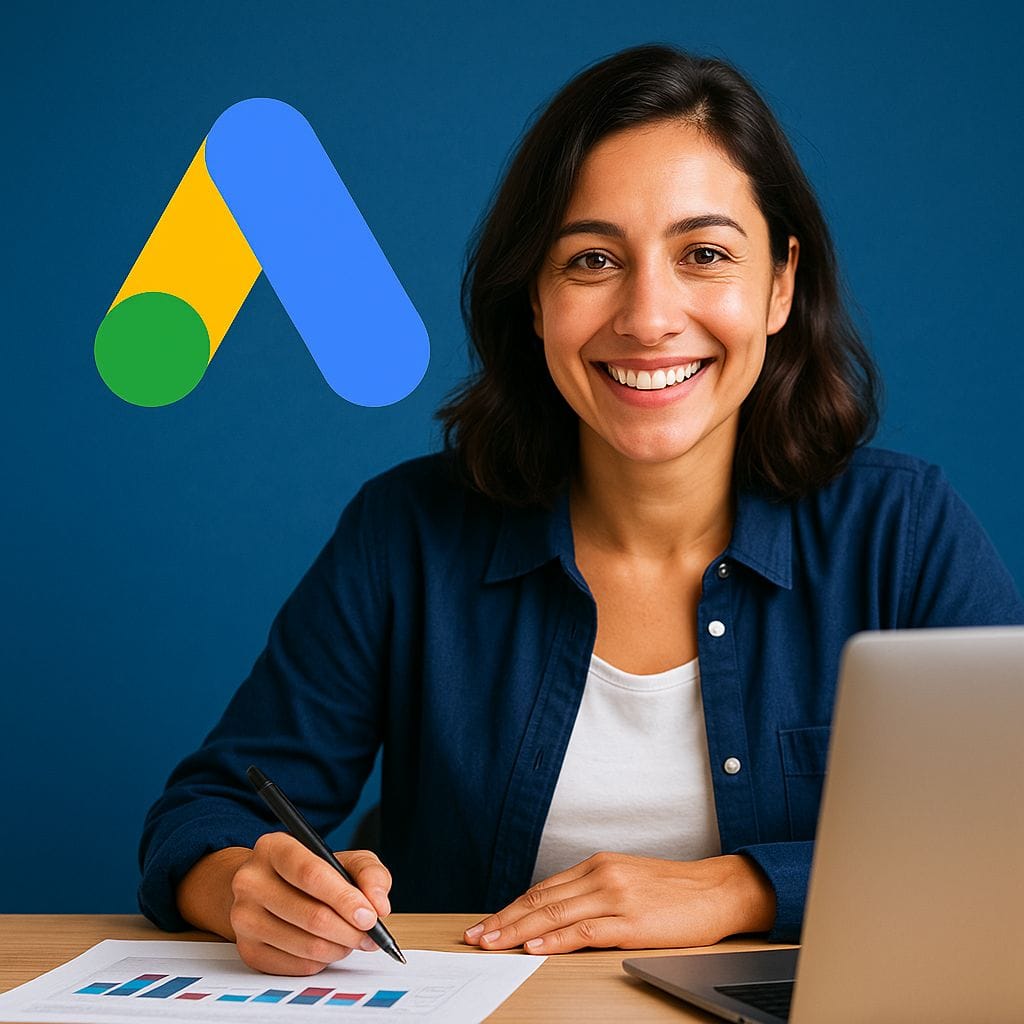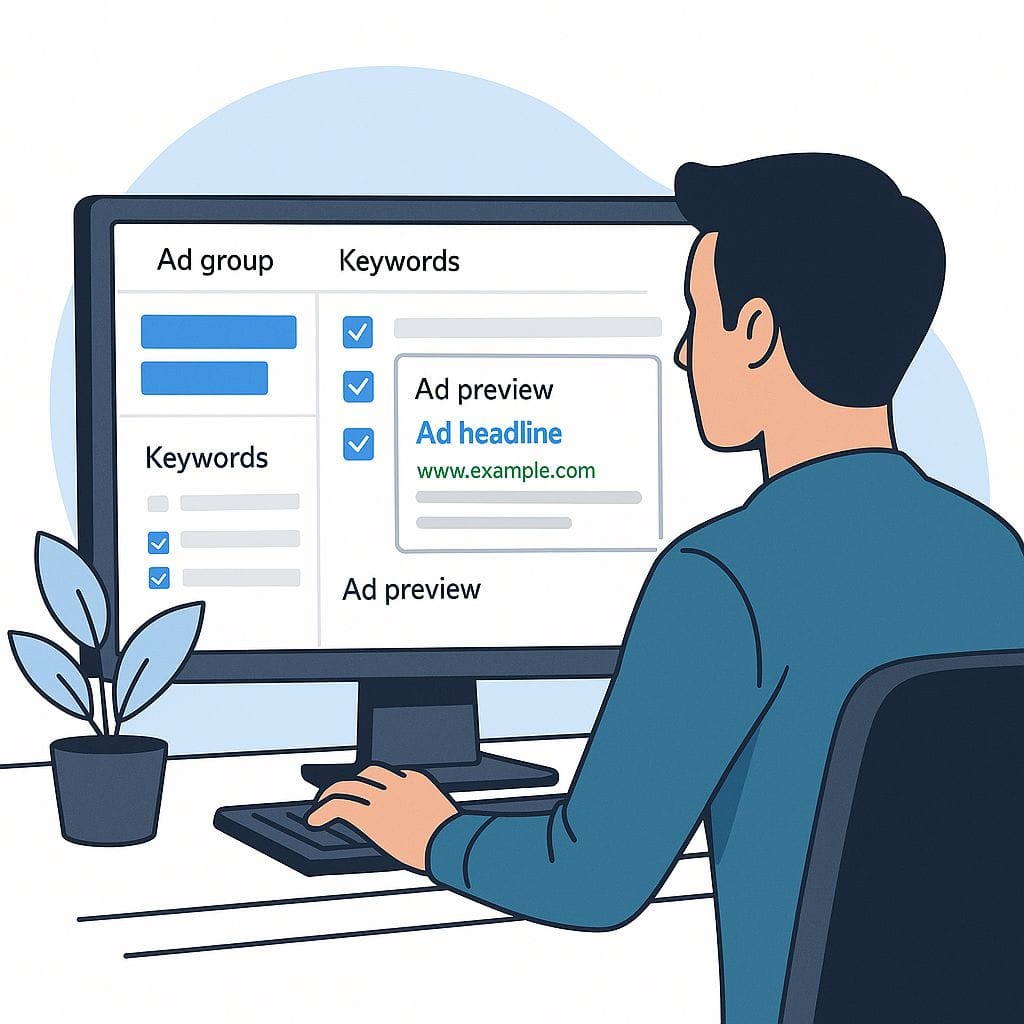Are you struggling to understand which Google Ads campaign type is right for your business? Confused by terms like Performance Max, TOFU, or conversion tracking? You’re not alone. Most businesses waste their ad budget by launching without a solid, data-driven strategy.
As a Google-certified strategist with 22+ certifications and hands-on experience managing 60+ successful campaigns, I help global businesses eliminate guesswork. This expert guide will walk you through the best Google Ads strategy for 2025—one that aligns with your growth stage, buyer journey, and goals.
Whether you’re a local service provider, eCommerce brand, or consultant,
Whether you’re a local service provider, eCommerce brand, or consultant, this guide will help you:
- Choose the right campaign type
- Structure your ads for ROI
- Apply AI and funnel strategies for long-term growth
- Understand the best Google Ads strategy structure and tools
🟦What Makes the Best Google Ads Strategy?
A best Google Ads strategy isn’t about running ads—it’s about running the right ads, at the right time, for the right audience. The best Google Ads strategies share these traits:
Match campaigns to each stage of the customer journey (TOFU, MOFU, BOFU)
Align with your business goal: traffic, leads, sales, or brand awareness
Set up conversion tracking to measure what matters
Combine smart automation (AI) with expert control
Use retargeting and customer lists to maximize efficiency
💡 If you’re not sure where to start building your best Google Ads Strategy, visit the Google Ads Strategy page or book a free audit for personalized help.
🟦Types of Google Ads Campaigns (Explained Simply)
Each campaign type serves a different purpose. Here’s a breakdown you can follow to structure your best Google Ads Strategy:
🟩 Search Campaigns – High-Intent, Fast Results
- Best for: Local businesses, service providers, and branded terms
- Strategy: Target keywords with purchase intent, use call extensions, direct to high-converting landing pages
🟩 Display Campaigns – Brand Awareness & Remarketing
Best for: Keeping your brand top-of-mind
Strategy: Use custom audiences, exclude poor placements, create click-worthy banners
🟩 YouTube Ads – Visual Campaigns That Scale
Best for: Brand storytelling and engagement
Strategy: Skippable ads, in-stream targeting, video hooks with strong CTAs
🟩 Shopping Ads – Perfect for eCommerce & Local Products
Best for: Online stores, retail businesses
Strategy: Optimize your product feed, set up Google Merchant Center, highlight best sellers
🟩 Performance Max – AI-Driven Omnichannel Reach
Best for: Scaling across Google’s entire network
Strategy: Build strong asset groups, use audience signals, set clear conversion goals
🟩 Local Service Ads – Only Pay for Qualified Leads
Best for: Verified service providers (plumbers, lawyers, roofers, etc.)
Strategy: Complete verification, add service areas, gather Google reviews
🔗 Learn more on the Services Page
🚫Common Mistakes to Avoid
Even experienced businesses fall into these traps:
- Launching without a conversion goal or funnel
- Using only broad match keywords
- Not setting up conversion tracking properly (Google’s guide)
- Ignoring audience signals or remarketing
- Letting AI auto-pilot without structure
🟦The 3-Stage Funnel Strategy You Should Follow
A key part of the best Google Ads strategy is aligning with how people buy. Here’s how:
- TOFU – Awareness Use Display and YouTube to generate brand awareness and attract cold traffic.
- MOFU – Consideration Use Search Ads and Discovery to engage those who are actively comparing solutions.
- BOFU – Decision Use Remarketing, Shopping, and Performance Max to convert warm leads into customers.
👉 This is the secret behind profitable Google Ads campaigns: mapping ads to each buyer stage.
🟦Expert Tips for High-ROI Google Ads Strategy
Here’s what I use for every successful campaign:
- Use GA4 and Google Ads data together for better targeting
- Segment campaigns by goal, audience, and funnel stage
- Test ad copy regularly (A/B testing)
- Exclude low-performing placements and keywords
- Use remarketing lists and customer match for warm traffic
🟦Ready to Build a Custom Strategy That Works?
Don’t just launch ads — launch with a plan. As a certified Google Ads specialist, I’ll build your best Google strategy based on your goals, market, and customer behavior.
🎯 Book your free strategy session and get:
Personalized campaign roadmap
Full-funnel recommendations
Budget planning and optimization tips
🟦FAQs – Best Google Ads Strategy
A funnel-based strategy with Search + Remarketing or PMax campaigns is often the best start.
Match the campaign type to your business goal and audience intent. Check my Google Ads Strategy page for help.
Most clients start seeing ROI within 30–45 days. For full scaling, expect 60–90 days.
Yes, and you should. The best results come from layered campaigns aligned to your customer journey.
Yes. Sending ads to a relevant, optimized landing page boosts conversions dramatically.

📢Final Takeaway: Let’s Build the Best Google Ads Strategy for You
This guide gives you the foundation, but if you want expert guidance tailored to your exact business — I can help.
📩 Request Your Free Audit and let’s build a strategy that performs in 2025 and beyond.
🔗 Also visit: Home Page | Services Page | Google Ads Strategy


Googling the right campaign type can be overwhelming, especially with so many options available. It’s interesting how Google Ads tailors to different industries and customer journeys. I’ve always wondered if smaller businesses benefit as much as larger ones from these campaigns. The emphasis on aligning with customer behavior makes a lot of sense, but how do you measure that alignment effectively? I’d love to hear more about specific examples where choosing the right campaign made a significant difference. Do you think there’s a one-size-fits-all approach, or is it always case-by-case? How do you determine what’s trending versus what’s actually effective?
This is a very insightful read! It’s true that choosing the right Google Ads campaign can make or break your ROI. I appreciate how it emphasizes aligning campaigns with customer behavior rather than just following trends. The step-by-step guide for tracking conversions sounds super helpful—I’d love to dive deeper into that. Do you think small businesses with limited budgets can still benefit from Google Ads effectively? Also, how do you determine which campaign type suits a niche industry? I’m curious to hear your thoughts on balancing creativity and data-driven strategies in ad campaigns. Would you say it’s better to experiment with multiple campaign types initially or stick to one and optimize it?
Choosing the right Google Ads campaign type is indeed crucial for maximizing ROI. It’s interesting how the focus is on aligning with the customer journey rather than just following trends. The step-by-step guide for tracking conversions sounds helpful, especially for business owners who might feel overwhelmed by the options. I wonder, though, how much flexibility there is in adjusting campaigns once they’re live. Would you say it’s better to start small and scale up, or go all-in from the beginning? Also, how do you ensure that the chosen campaign type remains effective as customer behavior evolves over time? It’s a lot to consider, but it seems like a solid approach to tailor ads to the buying process. What’s your take on balancing experimentation with sticking to proven strategies?
Google Ads seems like a powerful tool, but it’s not always clear which campaign type is the best fit. I appreciate the emphasis on aligning campaigns with customer behavior rather than just following trends. The step-by-step guide for tracking conversions sounds helpful, but I wonder if it’s beginner-friendly. Do you think small businesses with limited budgets can effectively use Google Ads without overspending? I’d love to hear more about how to measure ROI specifically for local service providers. What’s your take on the most common mistakes businesses make when starting with Google Ads?
This is a very insightful read! It’s true that choosing the right Google Ads campaign type can make or break your ROI. I appreciate how it emphasizes aligning campaigns with customer behavior rather than just following trends. The step-by-step guide for tracking conversions seems like a valuable resource, especially for business owners who might feel overwhelmed. I’m curious, though, how do you determine which campaign type aligns best with a specific customer journey? Also, do you have any examples of businesses that successfully tailored their campaigns this way? I’d love to hear more about real-world applications! What’s your take on balancing creativity with data-driven decisions in ad campaigns?
It’s interesting how Google Ads can be tailored to different industries and goals. I’ve always wondered if there’s a one-size-fits-all approach, but it seems like customization is key. The emphasis on aligning campaigns with customer behavior makes a lot of sense—it’s not just about following trends. I’d love to know more about how to identify the specific buying journey of my customers. Do you have any tips for small businesses just starting with Google Ads? Also, how do you measure the success of a campaign beyond just ROI? I think tracking conversions is crucial, but are there other metrics that are equally important? Would love to hear your thoughts!
Great questions—and you’re absolutely right, there’s no one-size-fits-all approach with Google Ads. Customization is everything, especially when it comes to matching campaign types with the customer’s buying journey. To identify that journey, start by mapping out common touchpoints: how customers find you, what info they need to trust you, and what pushes them to act. Use Google Analytics and customer surveys to fill in the gaps.
For small businesses just starting out, my top tips:
Start with a focused Search campaign targeting high-intent keywords.
Set up conversion tracking from day one.
Use location targeting and ad extensions to boost relevance.
Beyond ROI, key success metrics include:
CTR (Click-Through Rate): Are your ads attracting attention?
Conversion Rate: Are clicks turning into leads or sales?
Quality Score: This impacts cost and ad placement.
Impression Share: Shows how often your ads show vs. competitors.
This is a comprehensive guide on optimizing Google Ads campaigns for various business types and goals. It’s impressive how it breaks down strategies for different stages of the customer journey, from awareness to conversion. The emphasis on combining AI with expert control is particularly interesting—do you think AI can truly replace human intuition in ad campaigns? I also appreciate the focus on retargeting and customer lists, as these are often overlooked but can be game-changers. The step-by-step guide on tracking conversions seems practical, but I wonder if it’s beginner-friendly enough for someone just starting out. Overall, this feels like a solid resource, but I’d love to hear from someone who’s actually implemented these strategies—did they see a significant ROI? What challenges did they face?
Really appreciate your thoughtful feedback! AI is a powerful tool in Google Ads, but it works best when guided by human intuition—especially for understanding nuance, tone, and brand voice. The step-by-step tracking guide is designed with beginners in mind, and we’ve seen great results when paired with simple, clear goals. Retargeting and customer lists truly are underused gems—they often drive the highest ROI with the lowest CPC. As for real-world results: businesses that implement these strategies with consistent optimization typically see a solid uplift in ROI, but the biggest challenge is usually patience—data takes time, and testing is key. Happy to share specific examples if you’re exploring this further!
This is a comprehensive guide on optimizing Google Ads campaigns for various business types. It’s impressive how it breaks down strategies for different stages of the customer journey and specific industries. I particularly like the emphasis on combining AI with expert control—it feels like the perfect balance between automation and human insight. The focus on retargeting and customer lists is also a smart move to maximize efficiency. However, I’m curious about how small businesses with limited budgets can implement these strategies effectively. Do you think these tips are equally applicable to startups, or are they more suited for established businesses? Also, how do you measure the success of brand storytelling campaigns? Would love to hear your thoughts!
Thanks so much for the thoughtful comment! Glad the blend of AI and expert control resonated—it’s a game-changer.
To your questions:
1. Can startups use these strategies?
Definitely. Start with high-intent search campaigns, then layer in retargeting and customer lists as you grow. Smart prioritization makes even a small budget work.
2. How to measure brand storytelling?
Look beyond clicks—track engagement, view-through conversions, brand lift, and time on site. Syncing with GA4 or your CRM helps connect early awareness to real results.
Happy to dive deeper if you’re working on something specific!